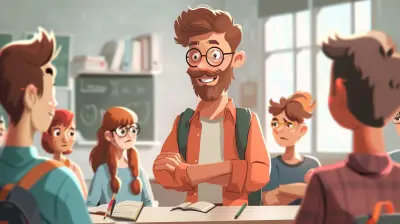Strategies for Teaching Critical Media Literacy
10 October 2025
Let’s face it — the media's influence is everywhere. From the scrolling hustle of social media feeds to the pop-up ads on websites to the 24-hour news cycle, we’re bombarded with content. And the kicker? Not all of it is trustworthy. That’s where critical media literacy steps in.
Teaching students how to decode, question, and analyze media messages isn't just a nice skill — it's essential. It's like giving them a pair of X-ray glasses to see through the noise and find the truth.
So if you’re an educator, a parent, or even just curious, stick around. We're diving into smart, practical, and engaging strategies for teaching critical media literacy in today’s digital jungle.
What is Critical Media Literacy?
Before we jump into the how, let’s talk about the what.Critical media literacy goes beyond simply understanding how to use media. It means digging deep — evaluating, analyzing, questioning the motives behind messages, and recognizing bias, manipulation, and misinformation.
It’s not just about what’s said — it’s why, how, and who’s behind it.
Why Does It Matter?
Well, think about it. We make decisions based on the media we consume — what we buy, who we trust, and even how we vote. Teaching students to critically evaluate media helps them become thoughtful, informed participants in a democratic society. And honestly? It protects them from being hoodwinked by sketchy influencers, fake news, or emotional propaganda.
Strategy #1: Start with What They Know — Social Media
Let’s be real. Try talking about media, and students might yawn. But mention TikTok, Instagram, YouTube — now you’ve got their attention.Use that!
Practical Tip:
Ask students to pick a post or video they've seen recently. Then dissect it. Who posted it? What's their goal? Is it an ad pretending to be entertainment? Is it pushing a certain point of view?This isn’t just an academic exercise — it’s personal. It gets them thinking about the media they consume every day.
Strategy #2: Make Media Analysis a Habit
Critical media literacy isn’t a one-time activity. It’s a skill that gets better with practice.How to Do It:
- Integrate media analysis into regular lessons.- Show a quick news clip or meme and have a five-minute discussion.
- Use exit slips where students write one thing they questioned in the media that day.
Over time, this creates a habit of skepticism (the good kind!) and reflection.
Strategy #3: Teach the Five Key Questions
These five questions act like a media decoder ring. Teach them, post them in the classroom, and refer back often:1. Who created this message?
2. What techniques are used to attract my attention?
3. How might different people interpret this message?
4. What values or points of view are represented (or left out)?
5. Why was this message sent?
These simple questions open up a world of critical thinking. They work whether students are looking at a commercial, a movie trailer, a political ad, or even a viral tweet.
Strategy #4: Debunk Fake News with Real Examples
Let's face it — fake news is everywhere. It’s sensational, it’s viral, and it’s dangerous.Teaching students to spot fake news is like giving them a mental spam filter. But don’t just talk about it. Show them real examples.
Try This:
- Bring in two articles: one from a trusted news source and one that’s shady or misleading.- Have students compare them using a checklist: sources cited, tone, sensationalism, grammatical errors, etc.
- Introduce fact-checking websites like Snopes or PolitiFact. Let them see how easy (and empowering) it is to verify info.
Strategy #5: Turn Students into Creators
You want students to really understand media? Have them create it.When students put together their own videos, blogs, or memes, they start to understand the choices that go into shaping a message — and how those choices affect perception.
Project Ideas:
- Create a public service announcement (PSA) about a social issue.- Make a fake ad for a fictional product, showcasing persuasive techniques.
- Re-edit a scene from a movie to shift the tone (turn a comedy into a horror trailer!).
Creating media helps students see that every media message is constructed — nothing is truly neutral.
Strategy #6: Bring in Diverse Voices
Media doesn’t just inform; it shapes our understanding of identity, race, gender, power, and history.So ask — whose voices are amplified? Whose are silent?
Action Steps:
- Bring in media from different perspectives — international news sources, community newspapers, podcasts from underrepresented groups.- Compare how different sources cover the same story.
- Encourage respectful conversations about bias, stereotypes, and representation.
This not only builds critical thinking but also empathy and global awareness.
Strategy #7: Decode Advertising Strategies
Ads are sneaky. They're flashy, emotional, and everywhere — on your phone, your TV, even your cereal box.Students should understand that ads aren't just selling products — they’re selling lifestyles and values.
What You Can Do:
- Break down common advertising techniques: emotional appeal, celebrity endorsements, bandwagon effect, fear tactics.- Analyze both traditional ads and influencer content. (Yes, that skincare influencer is basically a walking commercial.)
- Ask students to reflect: Would I actually want this product if the ad weren’t so persuasive?
This builds media awareness that extends beyond the classroom.
Strategy #8: Use Current Events
News is media, too — and it's an amazing teaching tool. It’s real, it’s relevant, and it’s constantly evolving.Use current events to spark discussion and teach critical media literacy in a real-world context.
Pro Tips:
- Have students track how different news outlets report the same event.- Identify bias through word choice, image selection, or framing of headlines.
- Encourage students to ask: What’s the agenda here? Is this reporting or commentary?
This takes media literacy from abstract to tangible — and way more relatable.
Strategy #9: Encourage Digital Citizenship
Being media literate means more than just analyzing content — it’s also about engaging responsibly.Talk to students about their role as digital citizens. What they post, share, like — it all matters. It’s their digital footprint.
Key Topics to Cover:
- Privacy and data protection- Cyberbullying and online etiquette
- The impact of misinformation
When students understand their role in the information ecosystem, they’re more likely to pause before hitting "share."
Strategy #10: Make It Fun and Interactive
Let’s be honest — nobody wants a lecture on media bias. But a meme war? A fake news scavenger hunt? Now we’re talking.Creative Ideas:
- Host a “Spot the Bias” contest with prizes.- Use interactive platforms like Kahoot or Quizlet to make media literacy quizzes.
- Have a debate: Is social media good or bad for society?
By making learning active and engaging, students not only grasp the concepts — they remember them.
Final Thoughts
Teaching critical media literacy isn’t about turning students into cynics. It’s about giving them the tools to think clearly and question wisely in a world that’s full of influence. Essentially, it’s like giving them a compass in the chaos.And the best part? These strategies don’t require a fancy curriculum or high-tech tools. Just curiosity, conversation, and a commitment to helping the next generation become savvy, responsible media consumers and creators.
Because in a world overflowing with messages, the most powerful thing we can teach is how to read between the lines.
all images in this post were generated using AI tools
Category:
Teaching StrategiesAuthor:

Eva Barker
Discussion
rate this article
1 comments
Karson Hines
In a world overflowing with information, the ability to discern truth from illusion becomes paramount. As educators, we hold the key to unlocking critical media literacy. What hidden narratives lie beneath the surface of the content we consume, and how can we empower our students to uncover them?
October 24, 2025 at 2:47 AM

Eva Barker
Absolutely! Empowering students to analyze sources, question biases, and seek multiple perspectives is essential in developing their critical media literacy skills.


